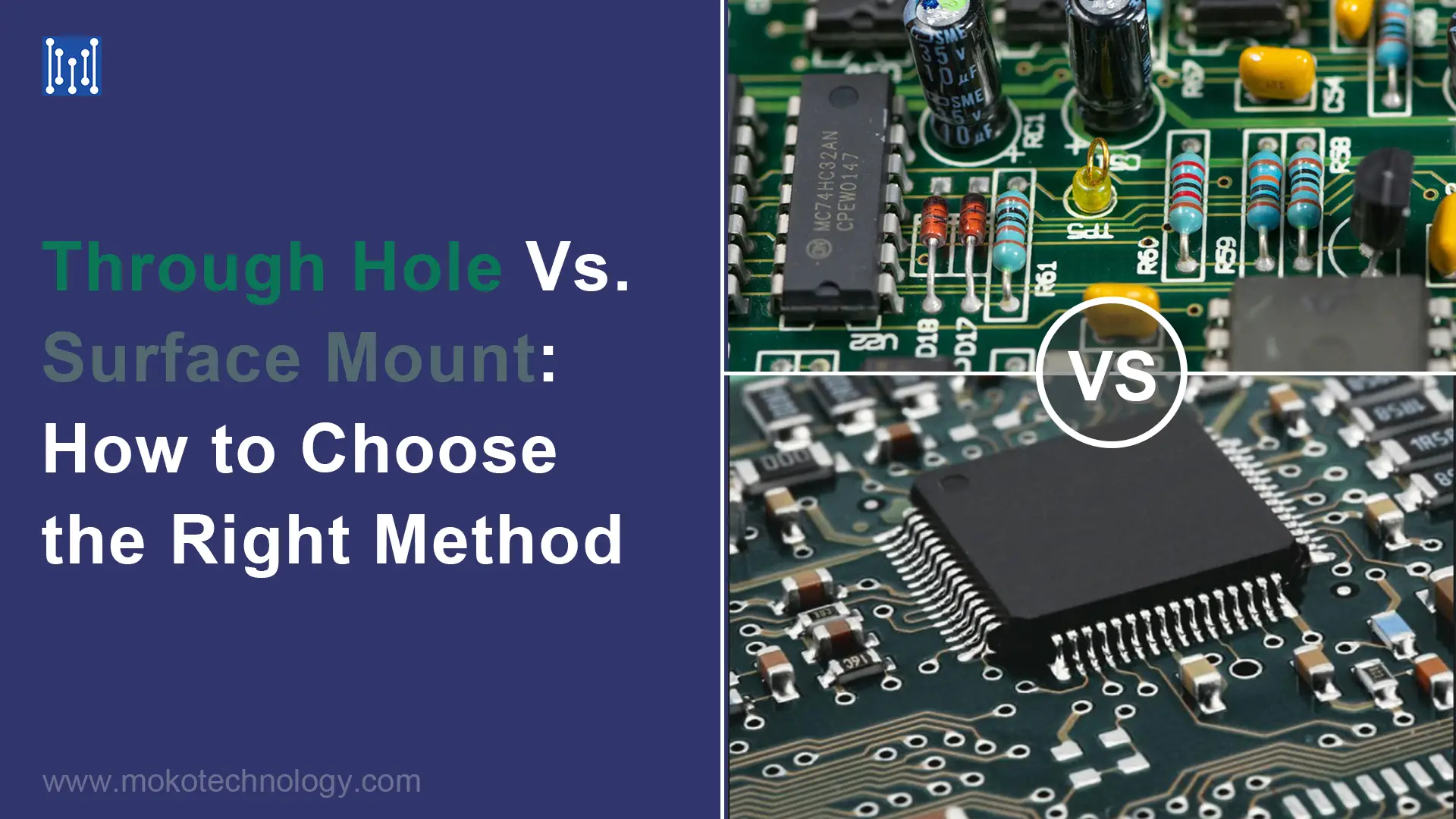Through Hole Vs. Surface Mount: How to Choose the Right Method


When assembling printed circuit boards, engineers have two main techniques to choose from: through hole and surface mount technology (SMT). In the early days, we dealt with components having long leads by inserting them manually into plated through holes on the PCB. We then soldered the leads to form strong interconnections with the holes. This is what we know as a through hole PCB assembly. With the passage of time, manufacturers prefer to use a modern assembly method that relies on components whose leads are only attached to the surface of the PCB. This method doesn’t require any mating hole. This is what we know as the Surface Mount Technology. Today we will look at both of these techniques and we will help you in choosing between them according to your needs.
Through Hole Assembly
Through hole assembly involves inserting component leads into holes drilled through the PCB and soldering them for both physical attachment and electrical connectivity. Common through hole components include integrated circuits (ICs), capacitors, resistors, inductors, transformers, fuses, and more.
Pros:
Components more durable and leads can withstand repeated soldering
Easy for technicians to handle and replace manually
Doesn’t need expensive SMT production equipment
Allows easy visual inspection of solder joint quality
Cons:
Larger components take up more space on the PCB
Hole drilling process adds steps
Overall slower manual assembly process
Not practical for extremely dense PCB designs
Surface Mount Assembly
SMT emerged to enable automated assembly of increasingly smaller and lighter electronics needing higher component density. Instead of wire-leads plugged into holes, surface mount devices (SMDs) have conductive pads that directly mount to the copper traces on the PCB surface.
Pros:
Much smaller components facilitate miniaturization
Far higher component density packable per square inch
Automated SMT pick-and-place machines enable speed
No drilling needed – simpler PCB fabrication
Solder paste and reflow methods efficiently secure small components
Cons:
Extremely difficult for rework/replacement manually
Needs investment in SMT production equipment
Challenging to visually inspect tiny solder joints
Comparing Surface Mount and Through Hole PCB Assembly
- The Assembly Process
SMT utilizes automated pick-and-place machines for rapidly mounting tiny components directly onto surface pads. This enables efficiency and consistency for high volume production. THT involves manual insertion of leaded components into drilled holes, securing with solder. While slower, this allows flexibility in low to mid-range quantities.
- Board Size
With miniature component sizes, SMT maximizes available space, accommodating complex, dense designs. The larger through hole parts occupy more area themselves. This can limit overall component density unless utilizing a bigger board.
- Temperature Factors
SMT typically utilizes advanced polymers and board materials with higher heat resistance, rated over 170°C. Through hole can employ traditional FR-4 rated around 130°C. This positions SMT well for high temp applications.
- Supported Components
The choice impacts your full bill of materials options. SMT utilizes fine-pitch ICs, BGAs, capacitors and other surface mount devices. THT selection includes leaded resistors, capacitors, transformers and sockets.
- Cost Considerations
For very high volume production, SMT’s automated efficiencies offer cost savings, despite initial equipment investments. However, THT avoids some expenses like solder stencils and is adaptable with manual tooling changes. Understanding volume tradeoffs is key.
Surface Mount Vs. Through Hole: How to Choose?
The optimum option depends significantly on production volume and complexity factors. Here are some guidelines:
Lower-Mid Volume, Less Complexity: Leaning towards through hole components makes sense for simpler boards not needing component density maximization. The flexibility can outweigh lower per unit costs, especially for volumes under 10,000 units.
Higher Volume Production: Once quantities exceed about 25,000 units, the automated assembly and soldering of SMT provides total cost benefits that are difficult for through hole to match.
Space-Constrained and Complex Designs: If achieving a very small form factor on a complex, component dense board, SMT is likely the necessity, as through hole parts simply can’t physically fit.
Mission-Critical Durability Requirements: For products where resilience to mechanical stresses or repeated disassembly for servicing are vital, through hole has inherent advantages from a ruggedness standpoint.
Final Thoughts
With this detailed comparison, we can safely conclude that surface mounted assembly is more cost-effective and efficient than the through-hole assembly. Most of the advanced electronic products involve surface mount technology. However, when we require special electrical, thermal, and mechanical applications then through-hole technology is still a viable option.
It is a fact that technology and science are making continuous progress. And it is also a fact that new products will replace old products. But it doesn’t imply that it is necessary to eliminate conventional technology. Merits of some conventional things can still make them play a vital role in the future to come.
As always, expert guidance from a PCB manufacturing expert is advised before finalizing hardware decisions. MOKO Technology has years of experience in PCB designing and manufacturing. We specialize in mass production using both the Through-Hole and Surface Mount Technologies. Feel free to reach out to us if you have any questions or if you want to inquire about a quote.
Recent Posts
Impedance Matching: A Critical Factor in High-Speed PCB Design
Impedance matching has become a cornerstone of the signal integrity in the realm of high speed PCB…
How to Clean a Circuit Board Safely and Effectively?
It is important to learn how to clean a circuit board properly if you’re working…
Counterbore vs Countersink: Which to Choose for Your PCB?
When designing PCBs, selecting the appropriate type of holes for fasteners is crucial. And much…
PCB Copper Foil: Types, Properties & How to Choose
PCB copper foil is one of the most critical materials in the printed circuit board…
MOKO Technology Launches Vietnam Manufacturing Base in February 2025
Shenzhen, China - February 11, 2025 - MOKO Technology, a leading global electronics manufacturing service…
PCB Solder Mask: What It Is and Why Every Circuit Board Needs It?
While most people focus on the components and copper traces that make up PCBs, there's…


